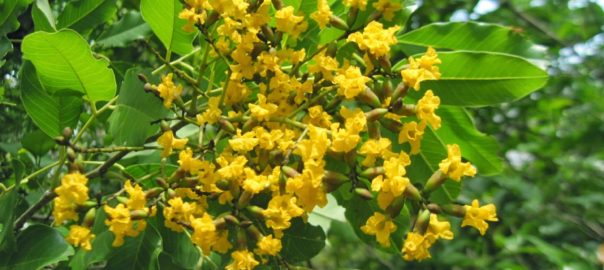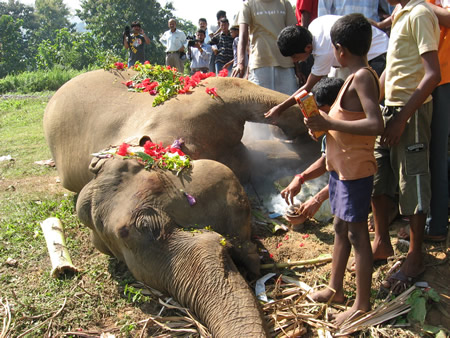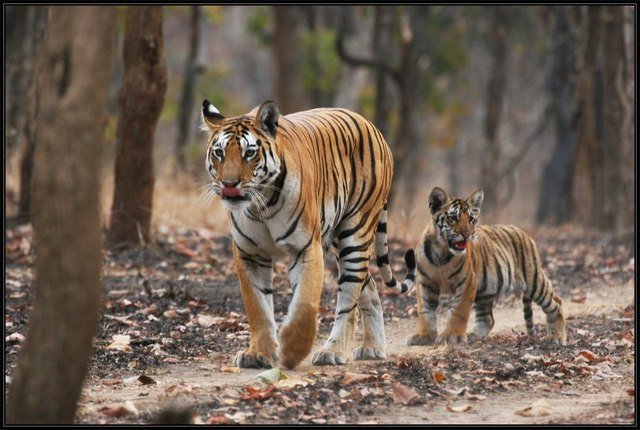Rainforest Trust’s partner Applied Environmental Research Foundation (AERF) in India uses unique economic opportunities to encourage communities to sustainably manage natural resources.
After dedicating extensive time and resources to planting saplings of a threatened tree species, many people would find it incredibly discouraging to come across a pile of these felled trees slated to be sold to a logging company. Instead, conservationists with the Indian environmental nonprofit AERF regarded the situation as an opportunity to engage with the community about local conservation and alternative economic possibilities.
The scientific name of this Vulnerable tree is Pterocarpus marsupium, though it is locally known as ‘Bija,’ ‘Vijaysar’ or the ‘Indian Kino Tree.’ The species grows in the moist deciduous forests of India’s north Western Ghats, a mountain range that is one of the most species-rich ecosystems in South Asia. Despite its high biodiversity, the northwestern section of the mountain range is severely under-protected. While there are ‘sacred groves’ in the region, which are old growth forest patches dedicated to deities that are traditionally protected by communities, there have been challenges associated with conserving private forests.
AERF acknowledges that conservation sometimes requires developing new value propositions for promoting sustainable biodiversity use so that reaping economic benefits doesn’t cause irreversible damage to the biodiversity. Since the fuel wood trade is a major source of livelihood for communities in the area, prohibiting the practice of cutting down trees may not be effectively enforced or economically viable. Recognizing this, the nonprofit discovered that community members could instead be educated to take advantage of their natural resources in a sustainable way.
Read More: How Do Plants Tell The Time Of Day?
“Once we got some success through community participation in saving sacred groves, communities started expecting more from us in terms of what direct benefits they can get,” said Jayant Sarnaik, the Joint Director of AERF.
“Conserving sacred groves partly was our agenda, but over a period [communities] realized that something linked to livelihoods could also be developed, and our organization could do something about that. That is how we diversified into developing alternative livelihood strategies, which are linked to conservation.”
Sarnaik explained that he got the idea of sustainably harvesting the Bija species when he saw local community members peeling the bark off the trees. When he asked people why they were doing this to the saplings that AERF had planted, the response was that the tree bark was used for traditional medicine. Sarnaik and his team recognized that a single tree could potentially have more economic value when used for its medicinal aspects than a whole forest plot sold for timber conversion, and so AERF began to approach landowners with a proposition: convert a minimum number of these trees that are at least 15 years old into profitable products through an AERF-implemented value chain, in exchange for conserving the majority of the forests that would otherwise be sold to logging companies.
“This initiative brings home the ‘golden mean’ of conservation-on-the-ground where sometimes one has to lose small battles to win the big war against mass-scale deforestation,” AERF explained.
AERF now cooperates with landowners and artisans to produce tumblers out of a limited amount of Bija trees that may help control blood sugar levels if a person drinks from them, while giving access to a larger market that allows for a fair price for the product. While providing a sustainable income to landowners, part of the proceeds are also used to protect the remaining and younger Bija trees in their forest plots.
Each product comes with a reminder: “The tumbler you hold in your hand is the ultimate sacrifice of one Bija tree whose valiant act saved countless others around it from being subjected to mindless logging.”
By using various economic incentives such as the tumbler production to limit the felling of trees in the north Western Ghats, AERF has scaled from protecting 50 acres in 2007 to currently safeguarding more than 3,500 acres, and is continuing to expand its protected areas through partnership with Rainforest Trust.
“What we are doing is not just looking at conservation practices of the communities, but also the traditional knowledge associated with species like plants and animals and how they can be used for conservation,” said Sarnaik. “Conservation doesn’t just mean protection. It also means sustainable use.”
This article was originally published in Rainforest Trust website. Re-posted here with permission.


 Flowering Pterocarpus marsupium. Photo courtesy of AERF.
Flowering Pterocarpus marsupium. Photo courtesy of AERF. Craftsman creates a tumbler. Photo courtesy of AERF
Craftsman creates a tumbler. Photo courtesy of AERF Tumbler created through AERF initiative. Photo by Rainforest Trust
Tumbler created through AERF initiative. Photo by Rainforest Trust


